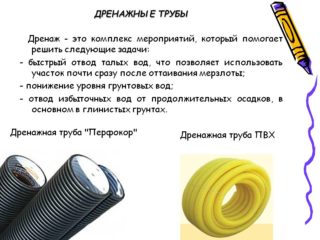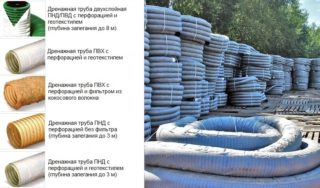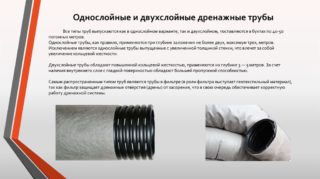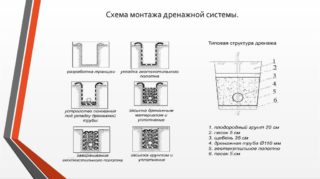Drainage pipes with perforations provide water drainage, collect moisture from the site and transport it. When installing the filter, the sewerage system is protected from dirt blockage.
Scope of application and principle of operation
By reducing humidity, mold will not form on the walls of the houses. The territory is protected from the formation of puddles, ice in the cold season. In gardens and vegetable gardens, plants will not suffer from excess moisture and will not rot.
It is most effective to use perforated pipes made of polymers in geotextiles for drainage systems. The principle of operation of a perforated drainage system is as follows:
- Water from the surface and from the soil enters the sewer system through perforations.
- Wastewater is discharged through a pipe into a well reservoir.
- A case made of geotextiles or geofabric acts as a filter from debris and sand.
Pipes are sold already with a filtration casing or wrapped with material immediately before laying in a trench. Without this, the system will constantly clog up and will not be able to function normally.
Specifications
- polyethylene (HDPE, LDPE);
- polypropylene;
- polyvinyl chloride.
Previously, asbestos-cement and ceramic products were used, but now they use polymer versions of perforated pipes. They are lighter, easier to install, cheaper and more resistant to negative external influences. With their low weight, they have high stiffness characteristics, which are given by special ribs that contribute to an even distribution of the load, even at great depths.
Polymer pipes are single-layer or double-layer, most often with a corrugated surface. With a small wall thickness, they do not lose their rigidity. It is for this reason that even products with a large cross-section have a relatively low weight, which greatly facilitates installation.
Due to the increased rigidity, double-layer tubular products can be carried out to a depth of 6 meters. Single layer pipes are limited to two meters.
Pipes are perforated in whole or in part. In the first case, the holes are located at a distance of 60 degrees around the circumference, respectively, along the section there are 6 perforations of 1.3 mm each. With regard to partial perforation, there are only three holes around the circumference of the product, which facilitates faster drainage of waste water.
Pipes are produced in six and twelve meter lengths or in rolls. Pipelines are also distinguished by the size of the section. Sizes - 110, 160, 200 mm. For household plots, models with a diameter of 110 mm are recommended.
Popular are flat drainage pipes, also perforated and in a filter. They have higher compressive strength, so the system can be laid close to the surface and save on excavation.Flat models fold more compactly for easier transport. With all the efficiency, they drain water just as well.
Selection of structural elements
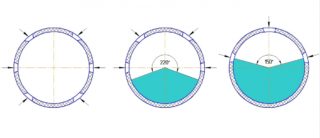
The main criteria for the selection of drain line parts are the degree of rigidity and the location of the perforations.
The first indicator depends on the depth of laying pipe lines: they must withstand the pressure of the earth layer on top. When purchasing pipes, pay attention to the markings indicating the stiffness class:
- SN 2-4 are suitable for depths up to 3 m;
- SN 6 - up to 4 m;
- SN 8 - up to 10 m.
Additionally, it is required to take into account the depth of passage of underground sources, the amount of precipitation and the method of installation of the drainage complex. These indicators are taken into account when choosing a perforation pattern. If the holes run over the entire surface around the pipe, it is chosen to reduce the level of groundwater, drain the effects of rainfall and snowfall.
For storm drains, products with perforation of segments in a third or two-thirds of a circle are suitable. Half-circle holes are typical for universal piping.
When choosing pipes, it is necessary to take into account their cost. The price per running meter of perforated drainage pipes in geotextiles depends on the size and manufacturer. On average, a meter of a pipeline with a cross section of 110 mm costs 55 rubles, 160 mm - 110 rubles and 200 mm - 185 rubles. For flat pipes, the price per running meter starts from 75 rubles.
Laying and installation rules
Closed installation technology is more common, which implies deepening pipes into the ground. When arranging a deep drainage system, it becomes possible to divert underground currents located above the level of pipe laying. A similar technique is suitable for draining the earth and moving water from places where it accumulates - drains, summer showers, baths or swimming pools.
System installation steps:
- Map the highways and mark the area.
- Dig a trench to the desired depth, taking into account the condition of the earth, the level of underground currents and the load class of the selected pipes. The ditch should be 40 cm wider than the outer diameter of the pipeline. The ditch is made with a slope of three degrees towards the drain.
- Place a sand and gravel cushion at the bottom of the trench. The thickness of the sand layer is not less than 100 mm, taking into account the compaction, the upper crushed stone layer is not less than 200 mm.
- Connect the pipe sections with couplings.
- Check the slope with a regular cord stretched along the entire pipeline.
- At turning points and places of drops, equip inspection chambers with covers to clean and monitor the condition of the drainage system.
- Fill the pipes first with rubble, then with sand, and then with a layer of soil. Sometimes backfilling is carried out only with gravel or expanded clay.
The effluent is discharged into an open water body or rain sewer. A non-return valve is installed at the end of the drain pipes. If it is impossible to ensure such an exit, it will be necessary to create a collecting well, from which the collected liquid is pumped out from time to time.
A competent choice of a perforated pipeline and correct installation will significantly increase the service life and efficiency of the drainage system.

